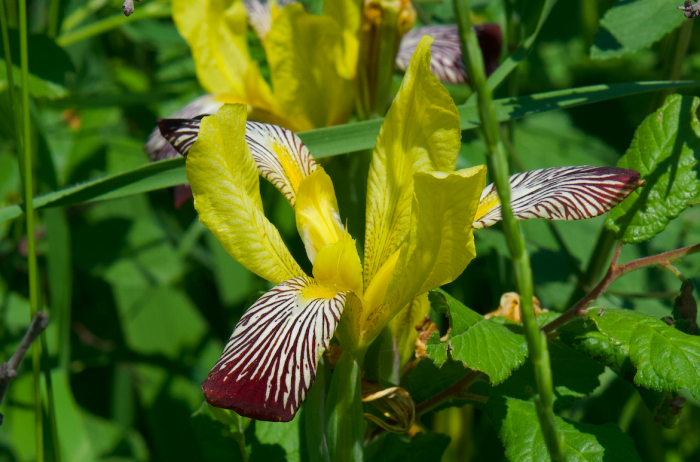Hungarian Iris
(Iris variegata)
Hungarian Iris (Iris variegata)
/
/

Conrad Altmann
CC BY 4.0
Image By:
Conrad Altmann
Recorded By:
Copyright:
CC BY 4.0
Copyright Notice:
Photo by: Conrad Altmann | License Type: CC BY 4.0 | License URL: http://creativecommons.org/licenses/by/4.0/ | Rights Holder: Conrad Altmann | Publisher: iNaturalist | Date Created: 2019-06-10T14:30Z |


















































Estimated Native Range
Summary
Iris variegata, commonly known as Hungarian Iris, is a deciduous perennial herb native to grasslands, meadows, and the edges of forests in Central and Eastern Europe. It typically grows to a height of 2-3 feet (0.6-0.9 meters) and a width of 1-2 feet (0.3-0.6 meters). The Hungarian Iris is characterized by its sword-shaped leaves and distinctive flowers, which are most commonly blue, blooming in late spring to early summer. Each flower is adorned with yellowish-white standards and drooping falls that feature striking brown-purple veins, making them quite showy. The plant’s rhizomatous nature allows it to form clumps that can be used effectively in border plantings or as a focal point in garden designs.
The Hungarian Iris is valued for its beautiful flowers and ability to adapt to a range of garden conditions. It is often used in perennial borders, water garden margins, and as a feature in rock gardens. While it prefers full sun, it can tolerate partial shade and requires well-drained, fertile soil to thrive. Regular watering is important, especially during the growing season. The plant is known for its hardiness, surviving cold winters by dying back to the ground and re-emerging vigorously in spring. Gardeners should be aware of potential issues such as iris borer, rhizome rot, and leaf spot diseases. Cultivars offer variations in flower color and pattern, providing additional options for gardeners.CC BY-SA 4.0
The Hungarian Iris is valued for its beautiful flowers and ability to adapt to a range of garden conditions. It is often used in perennial borders, water garden margins, and as a feature in rock gardens. While it prefers full sun, it can tolerate partial shade and requires well-drained, fertile soil to thrive. Regular watering is important, especially during the growing season. The plant is known for its hardiness, surviving cold winters by dying back to the ground and re-emerging vigorously in spring. Gardeners should be aware of potential issues such as iris borer, rhizome rot, and leaf spot diseases. Cultivars offer variations in flower color and pattern, providing additional options for gardeners.CC BY-SA 4.0
Plant Description
- Plant Type: Herb
- Height: 2-3 feet
- Width: 1-2 feet
- Growth Rate: Moderate
- Flower Color: Red, Yellow
- Flowering Season: Spring, Summer
- Leaf Retention: Deciduous
Growth Requirements
- Sun: Full Sun
- Water: Medium
- Drainage: Medium
Common Uses
Bee Garden, Bird Garden, Butterfly Garden, Deer Resistant, Hummingbird Garden, Low Maintenance, Rabbit Resistant, Rock Garden, Showy Flowers
Natural Habitat
Native to grasslands, meadows, and the edges of forests in Central and Eastern Europe
Other Names
Common Names: Bunte Schwertlilie
Scientific Names: , Iris variegata, Iris reginae, Iris lepida, Iris leucographa, Iris rudskyi, Iris variegata var. pontica, Iris limbata, Iris mangaliae, Iris squalens subsp. lepida
GBIF Accepted Name: Iris variegata L.